If you find yourself in Stockholm during December, there is one thing you absolutely must do, and that is to visit the Skansen open-air museum! The bonfires spread throughout the park surrounded by traditional Christmas music floating through the air, and the smell of mulled wine (or glogg as they call it in Sweden) mixed with freshly baked bread is so intoxicating it can get anyone into the Christmas spirit! Suppose you’re lucky enough to visit on a snowy day? In that case, it is genuinely the most picturesque place to spend a winter’s morning!

I had been clamouring to visit Skasen at Christmas ever since my last visit to Stockholm. This park’s themeing changes throughout the year, and there is always something new to experience. Even if you’ve been before, visiting during a particular time of the year, especially a holiday, will always bring about new activities to explore, and you’ll be able to dive into one specific part of Swedish history.
Skansen might seem like it might be more for children, but I found that there was so much to see here for adults, especially those with a heightened sense of wonder and curiosity. Walking in the gates of Skansen allows you to transport yourself back in time to experience Sweden of years past before there were iPhones or wifi. When questions were answered by the people you knew, not the internet. Every baker, farmer, ironworker or shopkeeper here in Skansen will eagerly answer all your questions! Skansen is a place that piques your sense of questioning and intrigue and allows you to feel that sense of childish wonder once more.
History
Skansen was established in 1891. It was initially proposed as a way of preserving historic buildings that were in the process of being torn down throughout the country, replaced by more modern incarnations. Artur Hazelius, a former teacher, had become one of the country’s most prolific conservators. Hazelius had previously funded the construction of the Nordic Museum on the island of Djurgården. During a visit to King Oscar II’s open-air museum in Kristiania, Hazelius was inspired to create his own minature version of historic Sweden here in Stockholm.
Hazelius himself travelled around Sweden, collecting and selecting the most iconic houses and buildings to save and bring to his museum. Almost all of the buildings you see inside the park are original structures. Each one was carefully taken apart from elsewhere in the country and rebuilt here in Skansen. No modern techniques were used in any of the reconstructions to preserve the authenticity of the structure. Only three of the buildings you’ll see in Skanse are new constructions. Even these were made with traditional techniques, using historical floorplans and blueprints.
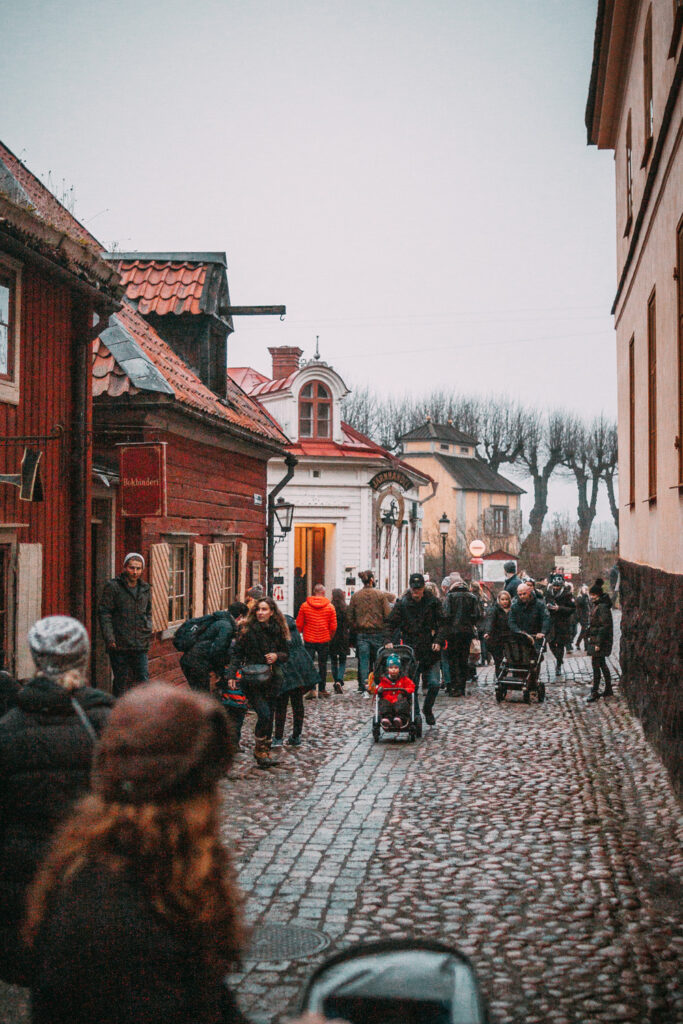
Visitor Information
Hours & Admission
Especially during Christmas, the park can get very busy, so it’s advisable to buy your tickets in advance. But if you arrive early in the morning and enter via the entrance mentioned below, you shouldn’t have to wait too long to get inside and buy your tickets.
Adults: 220kr ($25 USD)
Students & Seniors : 200 kr ($22 USD)
Children 4-15: 70 kr ($8 USD)
Children 0-3: free
Skansen is open from 10:00 am – 3:00 pm on weekdays, and 10:00 am – 4:00 pm on weekends.
The Christmas season at Skansen runs from the end of November into the first week of January. However, if you want to see the incredible Christmas Market, it is only open Friday, Saturday and Sunday from 26 November until 19 December. Check the website for exact details.
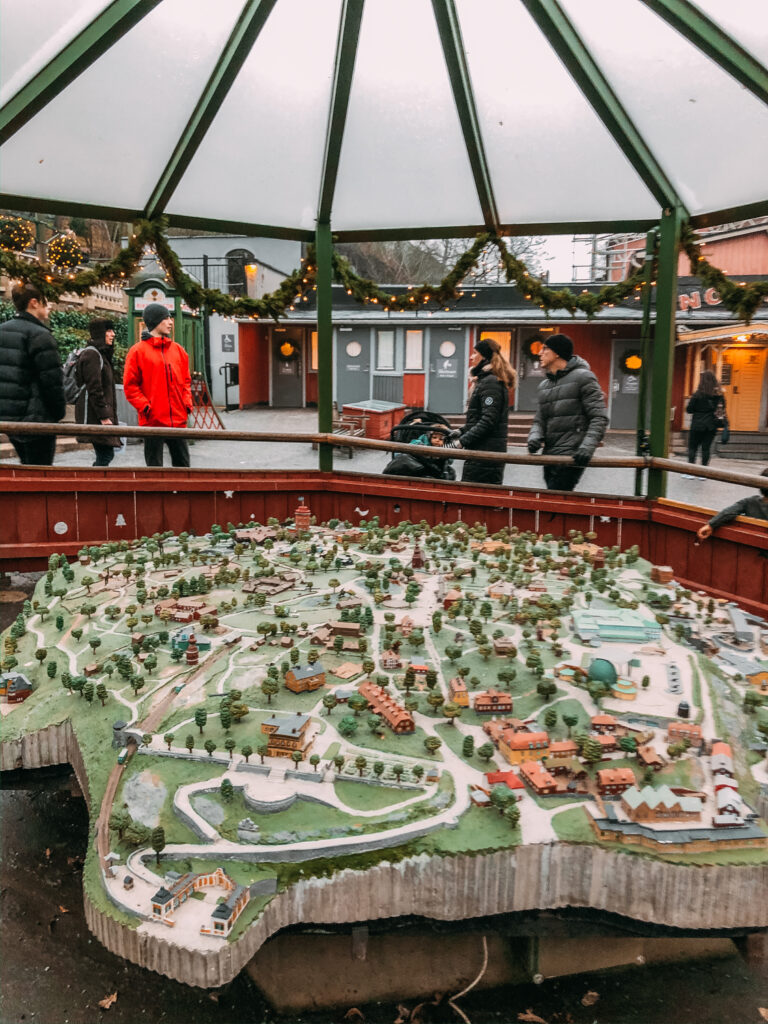
Location & Access
Skansen is located on the island of Djurgården. While it is possible to get here on foot and public transit, I think the best way to get to Skansen is via the ferry! I love the short but scenic journey onto Djurgården island on the ferry. The ferry number which will get your onto the island is ‘Djurgården 82‘.
If you are taking public transit, hop on the tram #7 or #13 to arrive at the front gates.
To get there on foot is a pretty enjoyable walk if you’re interested in taking the scenic route. Make your way to the Djurgårdsbron bridge, which will quickly lead you onto the island. From there, head along the sidewalk, enjoying the views of all the other museums on the island until you reach Skasen’s front gates.
Hazelius’ funicular entrance
There are two entrances to the park. One is called the ‘Hazelius’ entry, which is where you’ll find the old funicular. While Hazelius’ funicular entrance is perhaps a fun experience, this old method of transporting visitors up the hill is a relatively slow one. Far fewer people can enter the park via this entrance at one time. The funicular also costs 30 SK per adult.
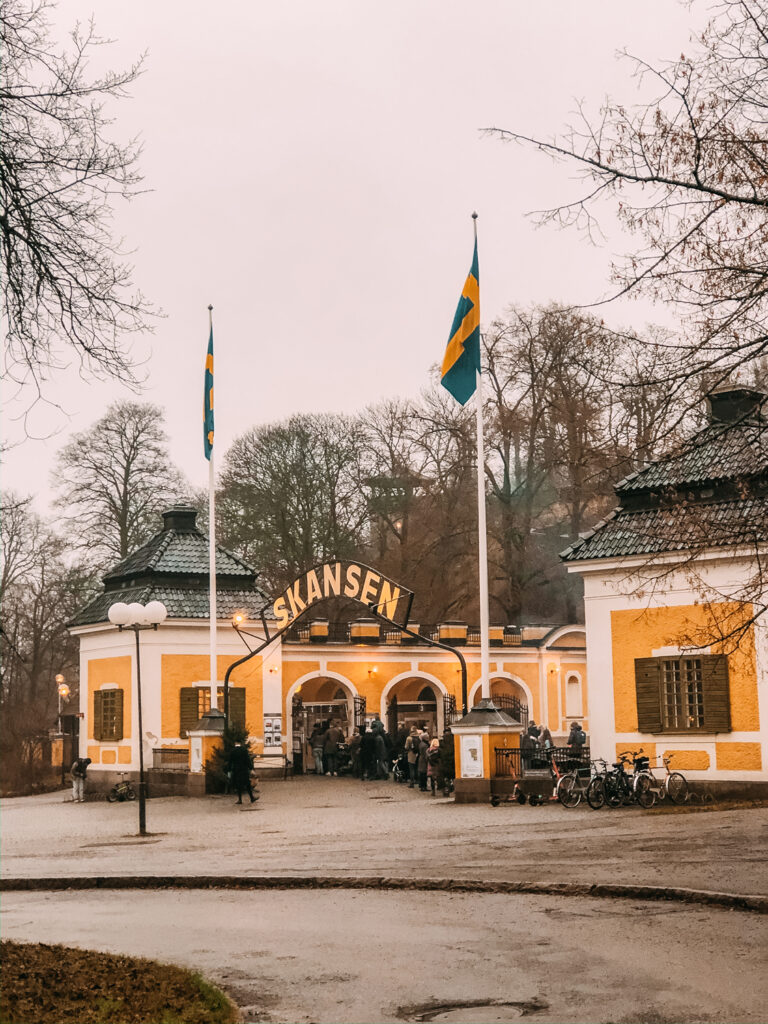
Djurgårdsvägen Entrance
The other entrance is further along Djurgårdsvägen. Use this entrance to get inside as it’s line moves much quicker than the previous one. Plus, the Djurgårdsvägen gate will lead you into the park right up to our guided tour’s starting point. Plus, the entry at Djurgårdsvägen is directly across from a tram station, making transit to the park super simple.

Accessibility
If you are in a wheelchair or have mobility issues, you can take the funicular up the hill free of charge. While the Hazelius’ funicular entrance is slower, it’s much much less strenuous. Many of the Skansen’s paths aren’t paved, so if you do not have a powered wheelchair, you might find you need to work a little harder around those rougher areas. There are ramps and elevators around the park to help you get around. Most of the buildings have been adapted to provide wheelchair and disabled access. They also offer free wheelchair rentals with a valid ID.
Accessible washrooms can be found at the main entrance, the Hazelius entrance, at the Forestry Center and behind the Högloftet.
Guide dogs are allowed in the park for disabled guests. They must wear a designated vest and have proper proof of vaccination since other animals in Skansen need to be protected.

When to Visit
The best time to visit the park is right when it opens! There is SO much to do here, and since on most days, the park is only open until 3 pm, its best to arrive early to maximize your experience. During the winter months, it also gets dark really early in the day, as early as 2 pm! Coming first thing in the morning will mean you can explore the park both during the daylight and after the sun goes down.
One of Skansen’s most unique events during the Christmas season is the St. Lucia celebration. St. Lucia (or Saint Lucy) was made a martyr after since brought food and aid to Christians hiding in the Roman catacombs. She wore on her head a candlelit wreath to light her way in the darkness, which allowed her hands to carry as much food as possible. Her feast day, which coincides with the shortest day of the year, is widely celebrated as a festival of light, and the festival in Skansen is a great way to celebrate this momentous Swedish tradition. The other event not to be missed here is Skansen’s, Christmas Market. The market starts on the first weekend of advent and runs until December 22nd. Check their calendar for the exact dates.
How Long to Spend
I would advise you to spend at LEAST three hours inside the park. But if you like shopping (like me), I could have spent a good three hours shopping alone! The Christmas market is such a great place to buy unique Christmas presents. If you have kids, they will really enjoy the animals at Lil Zoo within the open-air museum. Christmas time is busy at Skansen, and many of the historic buildings are relatively small. You might need to line up or return later to get inside and explore the scenes within. Remember, don’t try to rush through the park. Take your time and allow yourself to follow your interests or anything which excites you.
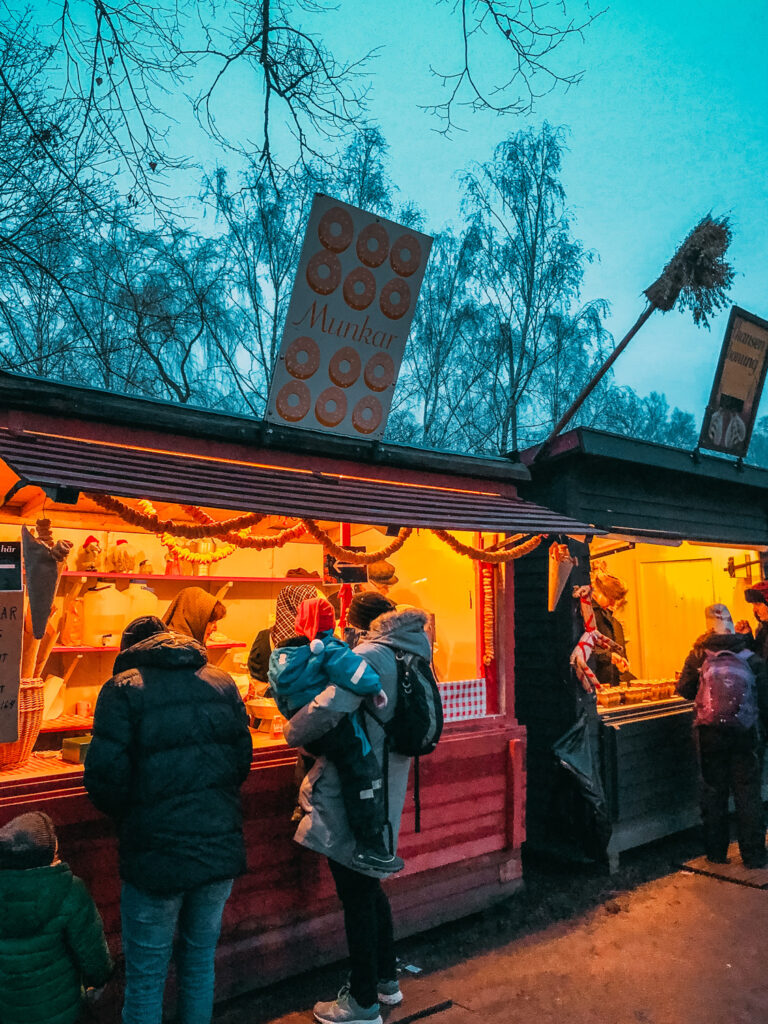
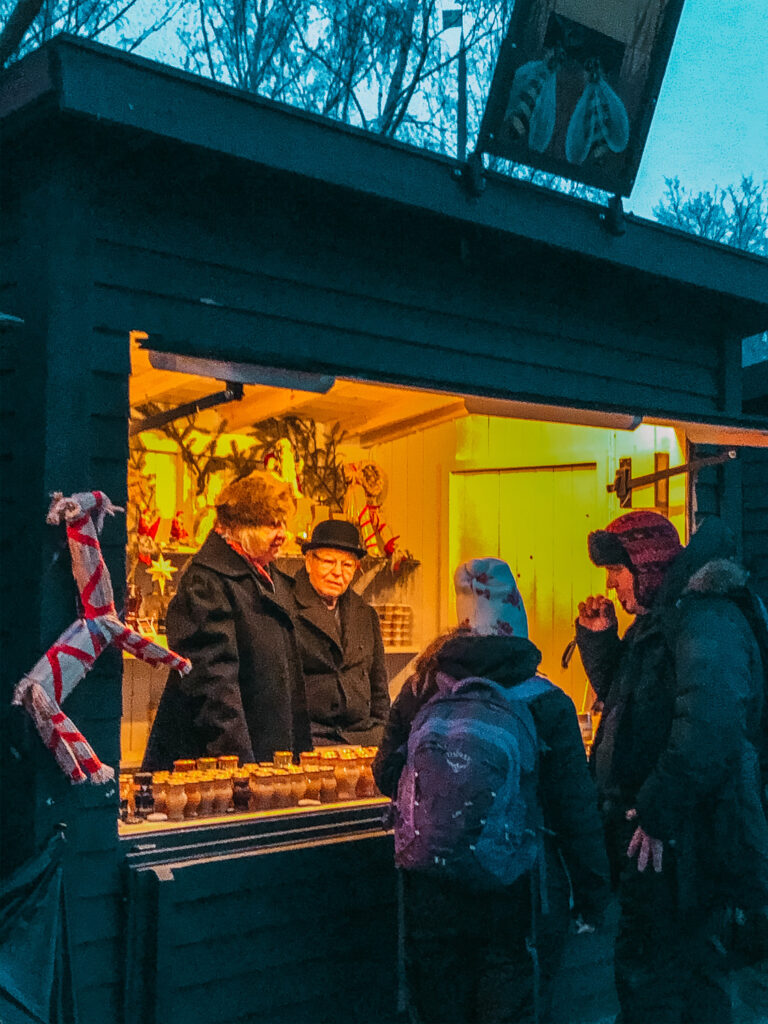
Essential Tips
If you have any questions along the way or just want to chat more about something you’re engrossed in, head right up to one of the people dressed in costume. They are happy to speak to you and will stay in character the whole time. Everyone speaks both Swedish and reasonably good English so don’t be shy!
Dress warmly. Most of the park is outdoors, and even the indoor buildings on the property don’t have central heating, so you must dress for winter success. I would recommend thermal layers that can go under your regular clothes, which help retain the heat but don’t require a wardrobe overhaul.

Your entry into the open-air museum will cover all access throughout the park, but things like food and souvenirs can rack up quite the cost as you’ll find out. Set yourself a budget. Skansen is a little bit like a historic Swedish Disneyland. You’ll want to have some money set aside to indulge in various traditional treats and buy some great keepsakes.

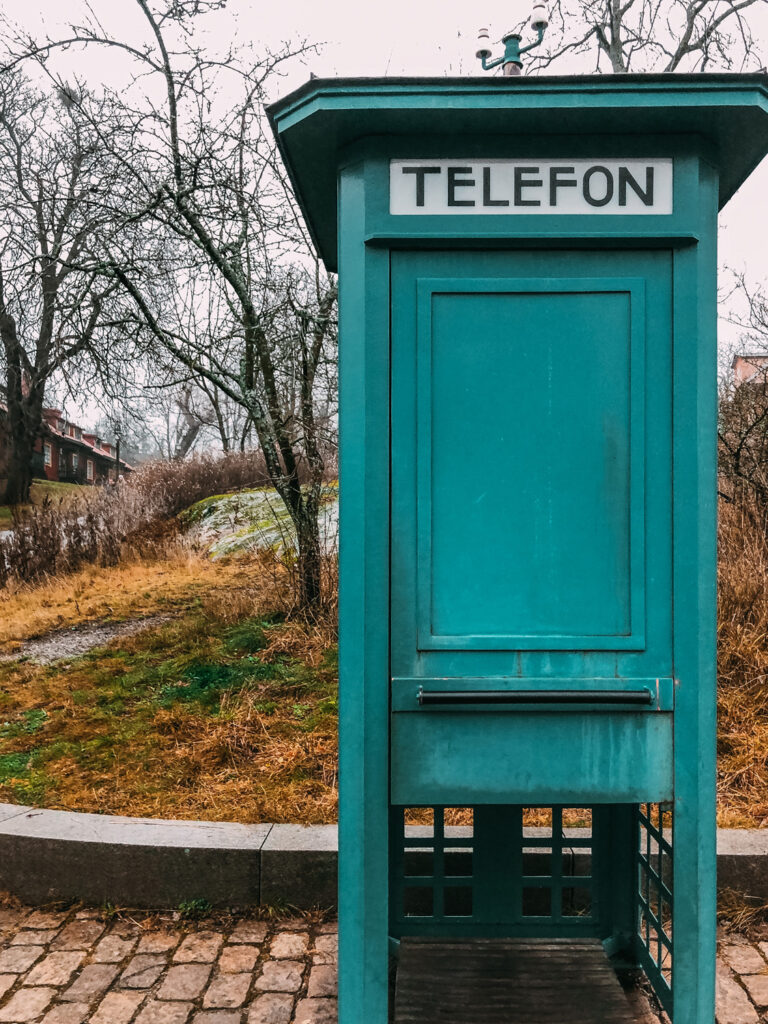
Self-Guided Tour of Skansen
After entering the park, head up the escalator to the left of the stairs. This will lead you to Skansen’s Old Town Quarter. This is a replica of what a Swedish town would have looked like at the turn of the century.
At Christmas time, the entire street smells like a giant campfire. Large bonfires are placed throughout the park to create a more enchanting atmosphere and help guests keep warm!

Glasswork Shop
Stop in on the left into the Glassworks building. Here, you can see craftspeople at work, demonstrating how glass Christmas ornaments were made. Glasswork was a massive industry in Sweden in the 19th century. The area between Växjö and Kalmar was once known as the “glass district,” and their wares were world-famous. Although other European cities would eventually overtake the market, it is interesting to learn about this art period in Sweden. A small shop is attached to the studio where you can also purchase some handmade ornaments for yourself!
The Potter Workshop
Inside this traditional workshop, you can see the old potter at work. Inside the studio, craftspeople make mugs, jugs and pots right in front of excited guests. After chatting in here, you can even head into the gift shop adjacent to buy some items made on-site using only old-school techniques. The various products’ designs have been modelled off original designs that that were brought for preservation to Skansen. Mugs and vases are always great Christmas gifts, and this is a gift with a great story behind it!
Bageriet
If you see a line out the door, this is no doubt the old bakery or Bageriet. I would still advise lining up even if it’s a bit of wait since backtracking back here is a pretty lengthy process. And these treats are really worth the wait! The bakery building is from 1870. Entering into the hot and smokey interior, you’ll notice that the room is dominated by the large brick oven. To get these ovens up to the proper temperature took hours. Once the oven was hot enough, it needed to be carefully maintained to not lose any heat. Bakers often work 16 hour days along with their apprentices, to create all the baked goods to feed a hungry city.
During the Christmas season, the bakery here bakes over 6,000 Pepparkakor cookies. These cookies are one of the most iconic seasonal treats eaten by Swedes. They are similar to gingersnaps but are much spicier as they do contain pepper (just like the name indicates)! A souvenir tin of these cookies is a perfect gourmet souvenir from Skansen.
Another item baked inside the Bageriet is lussekatter. You can watch bakers rolling out large sheets of golden dough ready to be formed into their popular “s” shape design. Lussekatter are saffron buns traditionally eaten on December 13th to celebrate St. Lucia (the patron Saint of Light). The buns shape resembles a cat curled up in a ball, and the raisins are placed as its’ eyes.
The Printer’s Shop
At the end of the quarter is the Printer’s shop, inside an old building from 1740. Here, you can see how books and papers were printed as late as the first part of the 19th century. This building contains enormous pieces of equipment used to hand-set type and rolls out the local newspapers across the country! As a designer, I shudder to think how long and painstaking it must have been to hand-place each lead letter to create one page of text alone!
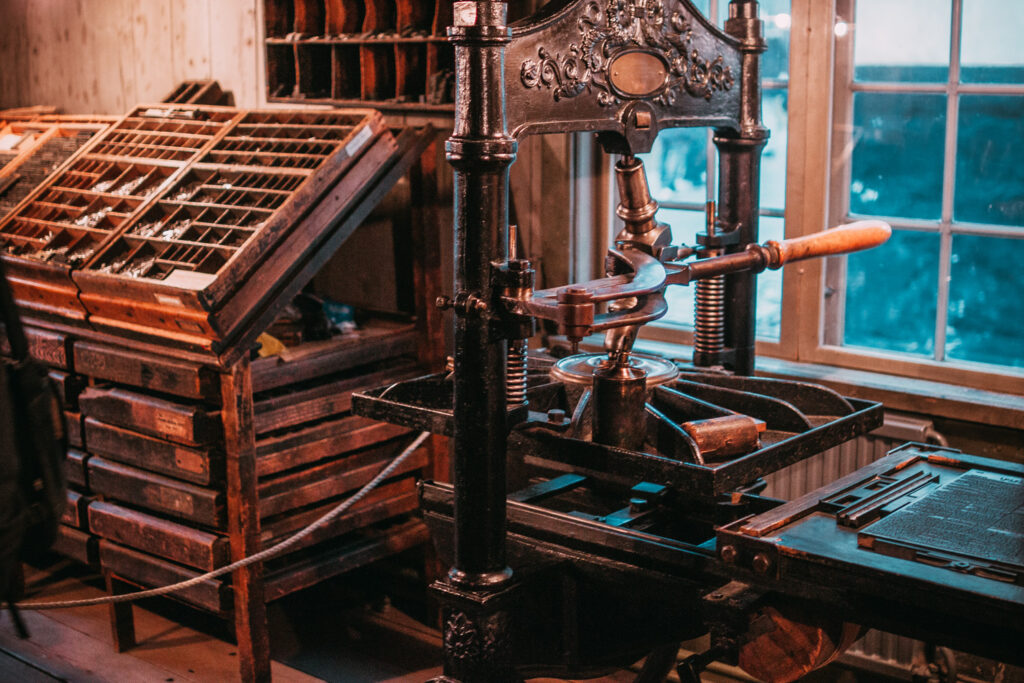
At the back of the workshop, there are beautiful engravings on display, used to create Christmas cards. Designs would be etched unto a rubber piece, which was then inked (just like the type was in the newspaper room) and stamped onto the paper cards. You can even take a free souvenir card with you from the collection they have there.

Printer’s home
Inside the Printer’s home, connected to the workshop, you can see a young couple who has prepared a Christmas dinner typical of the 1840s. Many of the early Swedish celebrations were influenced by pagan festivals. These included a midwinter celebration called “Jul,” where the aim was to eat and drink well. They baked bread and drank ale, still apart of traditional Christmas celebrations today! In this scene, you might notice that there is no Christmas tree to be found. This is because the custom of a Christmas tree wouldn’t be imported to Sweden until the 1880s.
Ironmonger & his Apartments
Besides, the cafe is the Ironmonger apartments. The ironmonger owns the hardware store in Skansen, located nearby inside an old building from 1930. He made goods for all the farmers, builders and households in town and therefore did quite well for himself and his family. His apartments are considered very modern for the 1930s. Inside, you can find all the mod-cons such as a water closet, electric stove and even a vacuum cleaner! During the Christmas season, his family is even baking cookies inside their brand new electrical oven!
During the winter holiday, you can visit the ironmonger’s apartment and see the family prepare their ice skating field trip with a packed lunch and warm clothing. In the ’30s, people started to have more leisure time to spend with their families.
Co-Op Store
Be sure to step inside the Co-Op grocery store Konsum. This is a 1930’s recreation of where locals would come to buy everything from butter, margarine, beer, soft drinks and sweets. You can also still buy some of these items from the shop, such as Christmas cookies. During the 30s Sweden had begun to embrace cooperative solutions as a way of changing society.
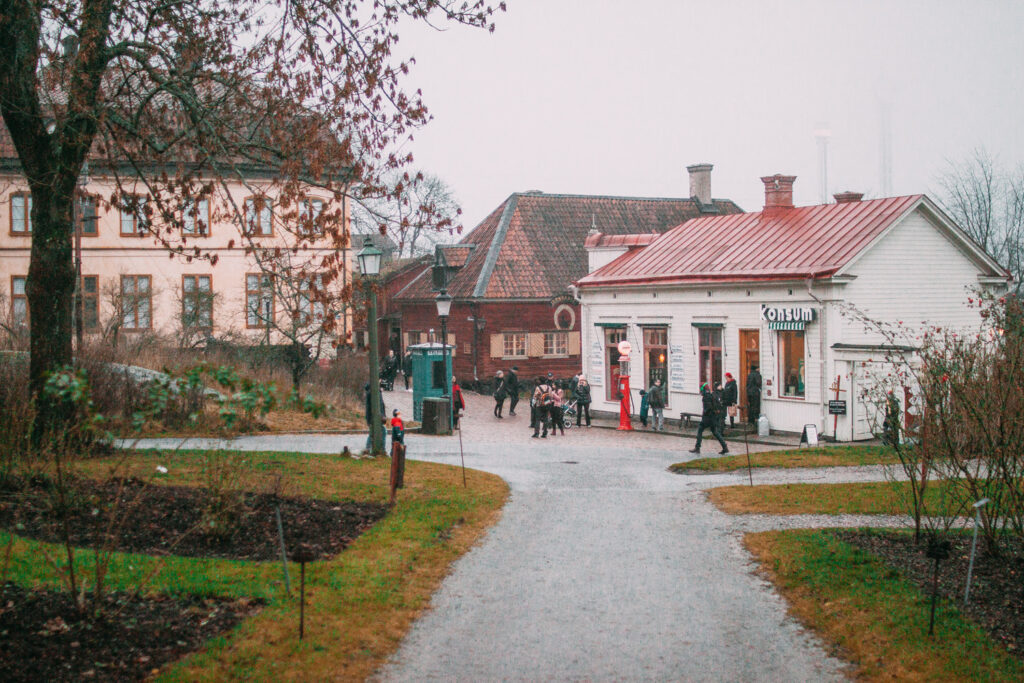
Herb Garden
Although there is not much to see in the Herb Garden during the winter, the view over Stockholm from this point is fantastic as it is one of the highest points in the park. Although it was a bit misty out when we visited, the eerie sight was still something to admire!
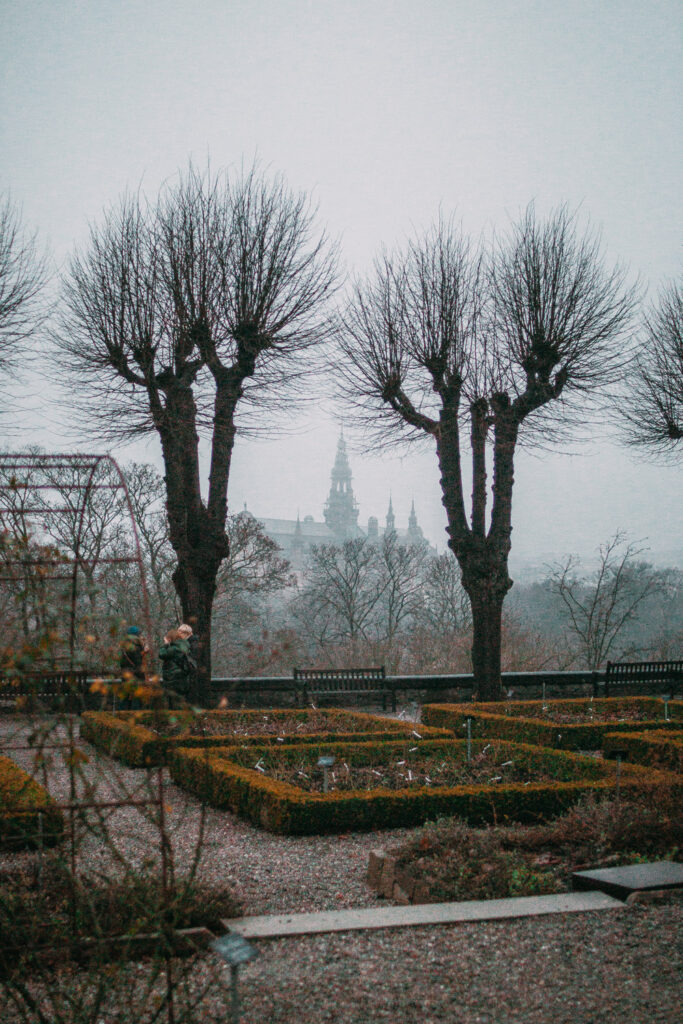
Café Petissan
If you feel the need to escape into the indoors’ warmth, head inside the Café Petissan. Here you can find all the traditional Swedish cakes, coffee and sweets your heart desires. You can try everything from; hot chocolate with whipped cream, freshly baked saffron bread, juicy chocolate cake, and their lovely gingerbread, a specialty in the winter. The Café Petissan was based on a real cafe that was popular with students from Stockholm University in the late 1800s. This quaint little shop gives you a sense of what dining as a bourgeois student would have felt like.
Apoteket Kronan
The Pharmacy or Apoteket Kronan isn’t perhaps the most “Christmassy” thing to do, but I’m a sucker for old pharmacies. Most of the items found in this shop are from the old royal pharmacy in Drottningholm, dating back to the latter half of the 18th century. During the colder months, people would come here frequently searching for remedies for their colds or sore throats. But back then, there wasn’t just a bottle at the ready with whatever you needed. In the 18th century, the pharmacist would have had to manually create a remedy from one of their ancient remedies. Everything from drugs, tinctures, ointments, powders, and pills was made in the dispensary laboratory.
Post Office
Stop by the Post Office to see delivery sacks filled to the brim with Christmas greetings! You can also find one of the traditional Yuletide trees decorated in the reception room. This building harkened from the early 20th century when Christmas trees were becoming en-vogue.
The Älvros Farmstead
The Älvros Farmstead shows what life was like in Härjedalen, located in northern Sweden. Take note of the people’s clothing at the various farmsteads as they change depending on their location and period. During the weekends, you can enter the farm and see them preparing the traditional Yule goat, an old symbol for Christmas.
The Bakehouse
Stop inside the Bakehouse from Jämtland where the women inside are busy making barley meal and turning it into fresh flatbread. After coming inside, they will even offer you some free flatbread straight from the oven.
The Bollnäs House
The Bollnäs House was a building brought from Dalarna, a county is located in the middle of Sweden. This house has the most richly decorated interior. The walls are all handpainted, signifying that this building was of utmost importance. It was used to hold celebrations such as weddings, christenings and Christmas feasts. The different murals on the walls depict scenes from the bible.
The Forestry Center
The Forestry center is primarily an educational facility. It also functions as a workshop for children where they can make traditional Christmas decorations during the holidays. This is a great place to get out of the cold if your kids need a break, but be aware there is a small fee for the craft supplies.
Delsbo Farmstead
Delsbo Farmstead is a building from the 19th century from the Swedish province of Hälsingland. This area was famous for the flax that was grown in the countryside. This raw material was very lucrative as it was used to make beautiful textiles and linseed oil. Walking inside, you can see the Delsbo farmstead’s magnificent interior. Since they had a little more money than some of the other ranches, they could decorate their interior with unique wall paintings and gorgeously furnished rooms.
The entire Christmas table is laid out in the kitchen and dining room as it would have been on Christmas eve. The housewife is on hand to explain all the different cultural traditions incorporated into the food and dining.
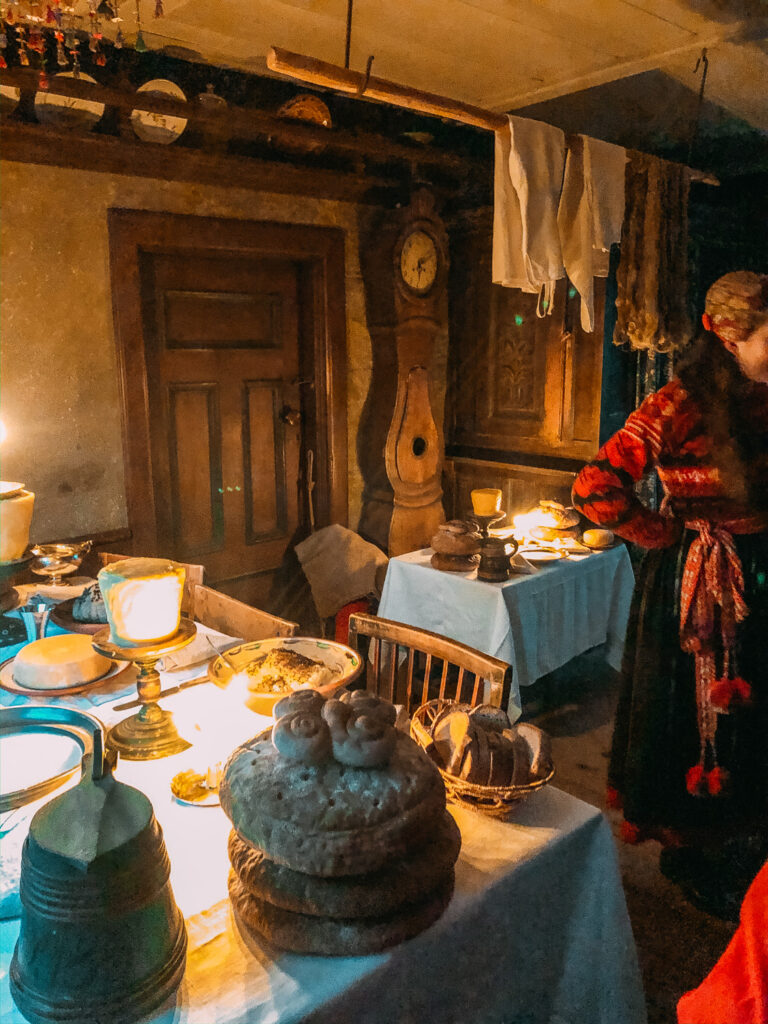
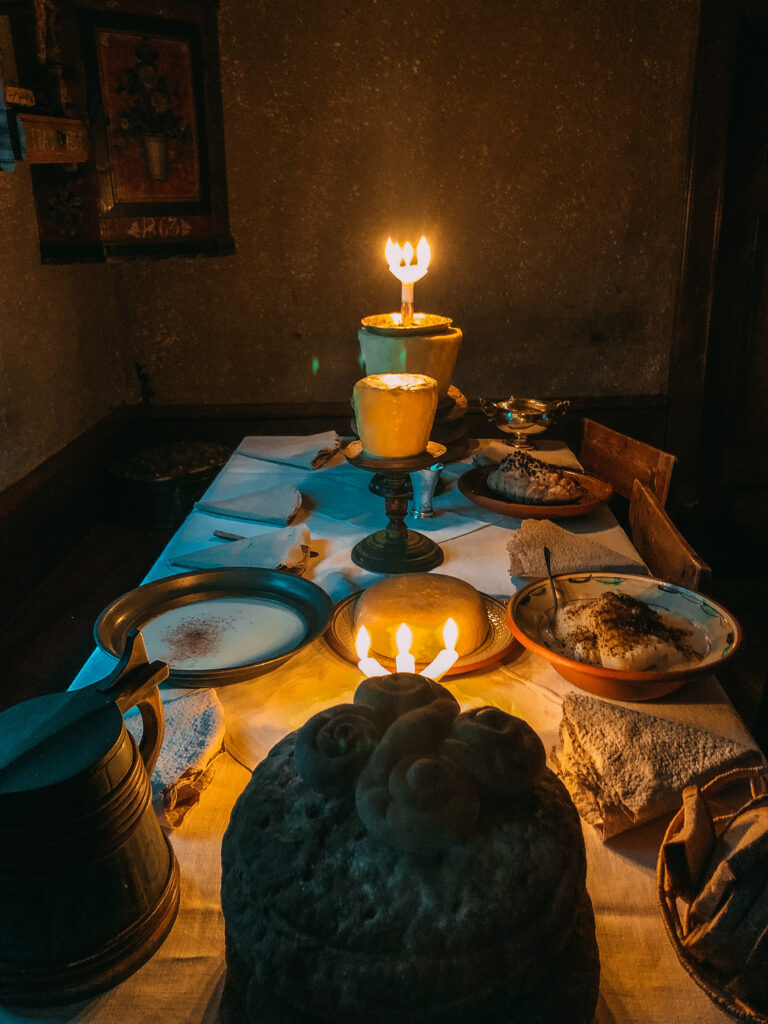
In the living room, beside the hearth, fiddle players entertain guests with traditional Christmas music. We sat here, keeping warm and listening to the mesmerizing tunes. It was one of my favourite moments of the entire day.

Animal Enclosures
Reindeer
Continue walking north along the cobblestone paths towards the animal enclosures. Here you’ll find one of the most iconic Christmas animals, the reindeer! Every day at 12:30, you can stop by the pen to learn more about the park’s reindeer during their daily lectures. For instance, did you know that the hairs in the reindeer’s winter fur are hollow? This helps the reindeer keep warm all winter, so they do not need to hibernate.

Moose
Moose are another animal worth seeing while in Skansen due to their importance in Sweden. Sweden has a denser Moose population than any other country in the world. There are around 400,000 moose in Sweden. Just under one third will be culled annually during the autumn moose hunting season, as moose is a popular meat eaten throughout Sweden.
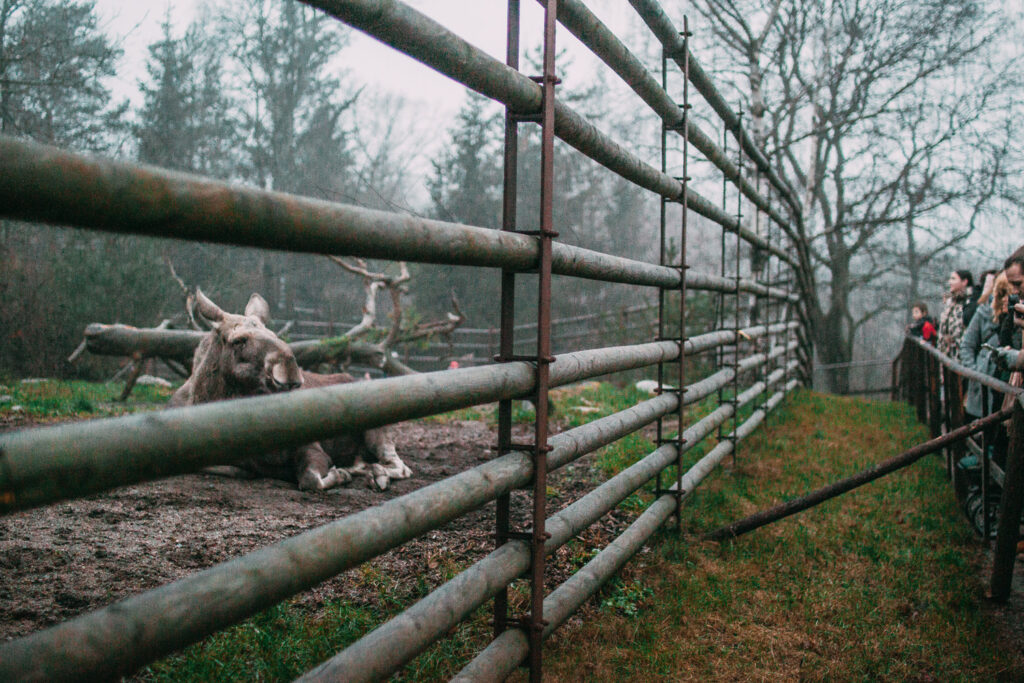
Stables
The stable near the Skansen Zoo is a great place to spot the Christmas Gnome, Tomte. He is known to take care of the animals in addition to being the symbol of Christmas for the Swedes. The horses are all decked out for Christmas with bells on their harnesses and red and white carriage.
Lill-Skansen
The Children’s Zoo or Lill-Skansen is an excellent place for the kids to play, but if you’re only a group of adults, it might be worth skipping. The Zoo has over 30 different animal species. The indoor area features small Scandinavian animals like toads, mice, guinea pigs, bunnies, goats and chickens. All of their cages were adorably decorated for Christmas, which was a nice little touch.

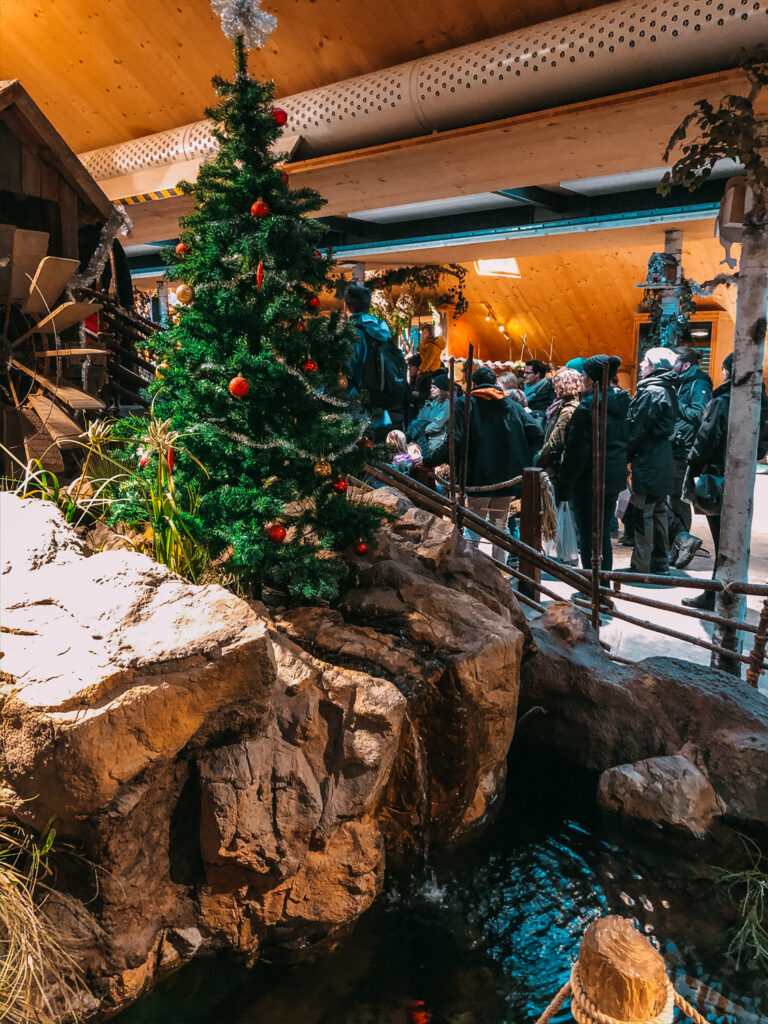
Bredablick Tower
Behind the Lil, Zoon is the great Bredablick tower. This 30-metre high brick structure was one of the buildings built on the site based on historical references. The name of the tower, Bredablick, is the name of the Norse God Balder’s home.
There are pony rides available outside the Christmas holidays outside he twoer from 12 pm to 3 pm on weekends and from 1 pm to 2 pm on weekdays. They cost SEK 50 ($5.50 USD) each.
Seglora Church
The grand Seglora Church is from the 18th-century church from Västergötland. To this day, you can still rent out the church to have your weddings, christenings, and even host concerts—all for the right price that is.

At Christmas time the best part about visiting the church is the Christmas musical performances which take place here. The music schedule will be on the brochure upon entry but are around 1 pm and 2:30 pm. There is something so peaceful about listening to this old kind of music style in this ancient setting lit only by candlelight.
Christmas Market at Skansen
After wandering through the old farmhouses, you come out onto the Marknadsgatan or Market Street. Here is where you’ll find the incredible Skansen Christmas Market! Since its inception in 1903, Skansen’s Christmas Market has become a beloved holiday tradition for Swedes and tourists alike. During the winter, all sellers must all dress in traditional garb, making visiting the market feel all the most festive!
The number of stalls here was almost dizzying. But the very first item on our list we needed to check off was to grab ourselves a glass of Skansen’s specialty, Saffron Glögg. If you haven’t tried glögg at Christmas time in Sweden, you haven’t been to Sweden. Glögg is sweetened, mulled red wine blended with a spice mixture of cloves, cinnamon, cardamom and ginger. Here in Skansen, they add saffron to the wine, making it taste even more delicious. Glögg can be purchased by the glass at the market or even buy entire bottles to take home with you!

Eating at the Christmas Market
If you’re looking for something to eat, then you’ve come to the right place. There are both items to eat there in the park or bring home with you all with a distinctly Swedish Christmas flare! Taste traditional sausages, holiday cheese, Skansen’s own handmade mustard, freshly made bread and cakes, sugared almonds, marzipan, crispbread, smoked turkey, jams and marmalades, more!
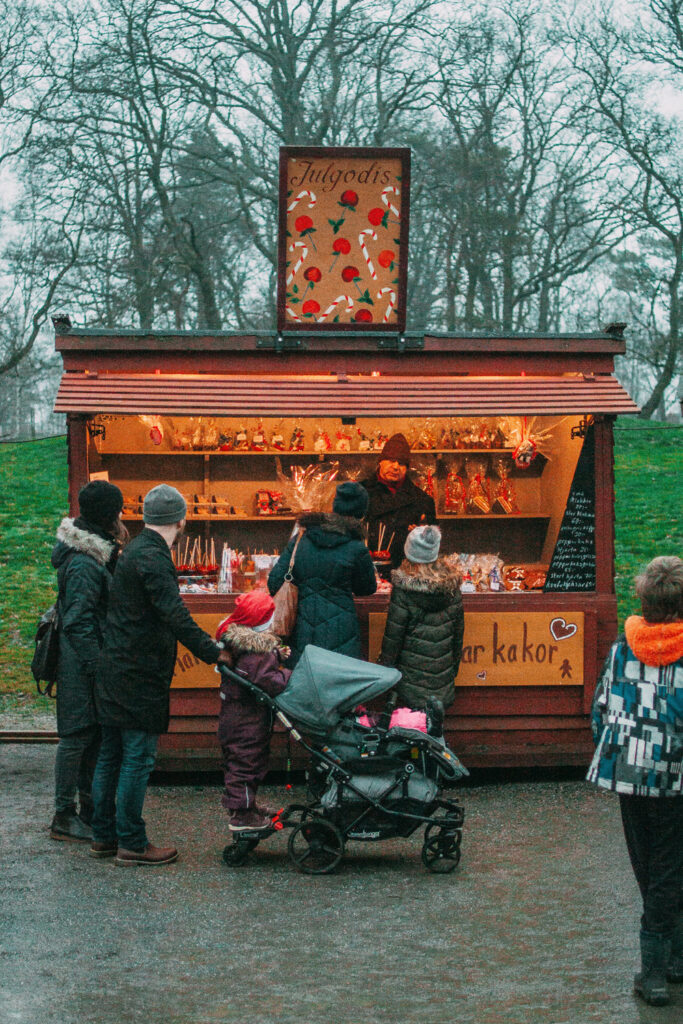
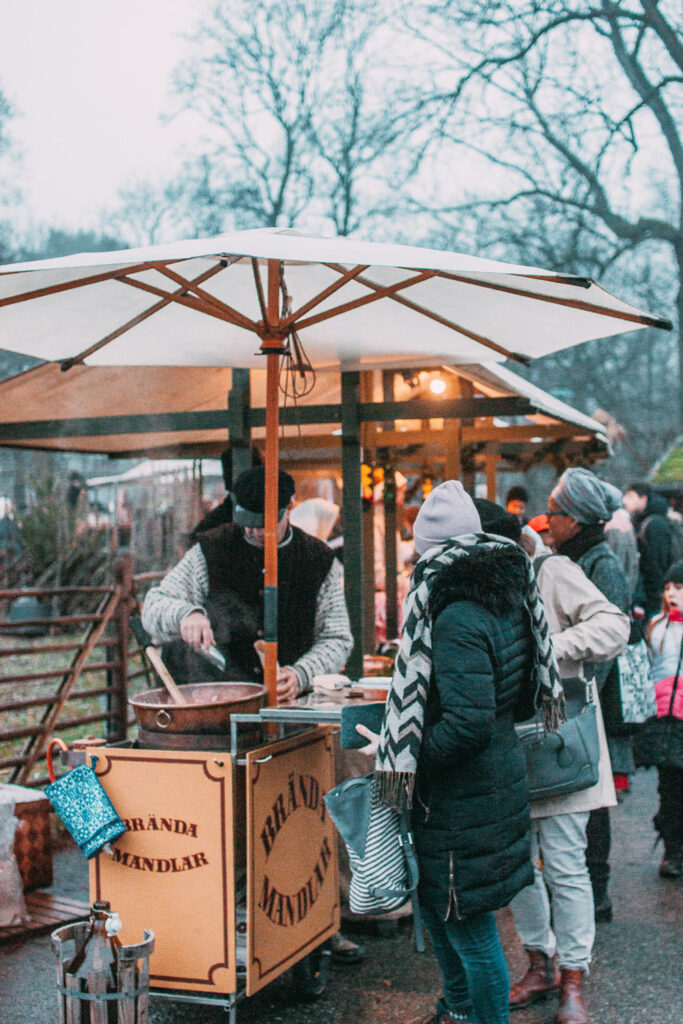
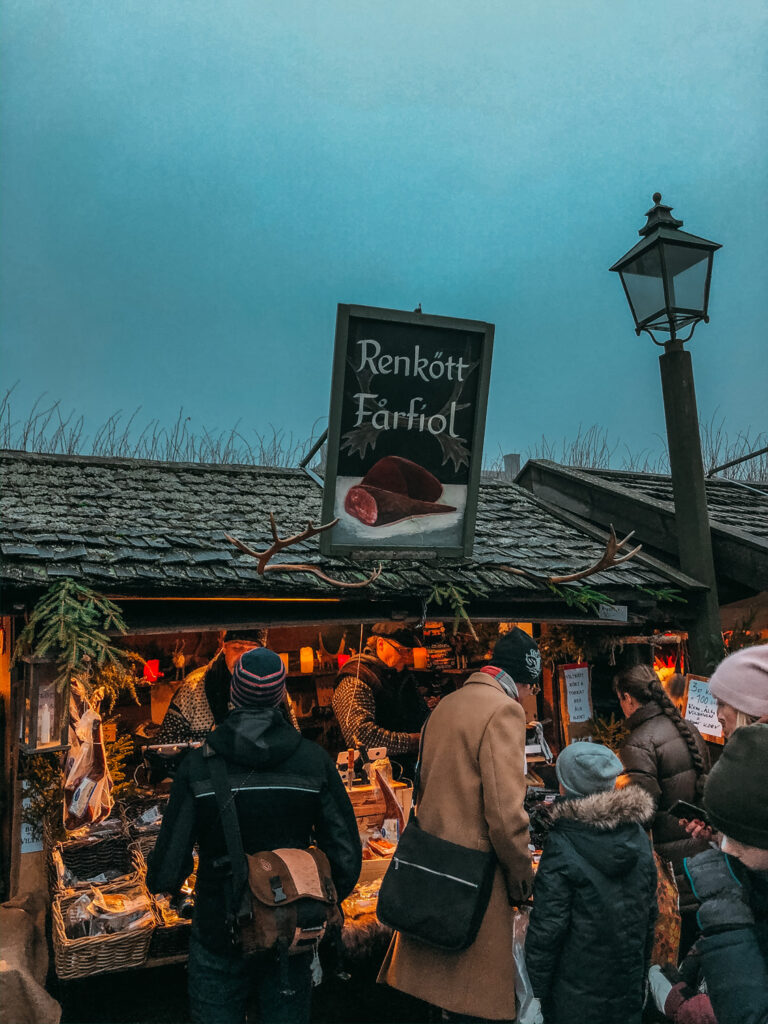

One of the most famous things to eat at Skansen is the Kolbullar. Kolbullar means “coal bun” as the dish is cooked over an open fire. They place cast iron pans on the bonfire and fry open a pancake covered with bacon and lingonberries (a local Swedish fruit). The batter bubbles away and steams like crazy in the freezing cold temperatures. After it’s finished cooking, it’s covered in brown sugar syrup. There is really nothing like it and so tasty!
Shopping at the Christmas Market
If you’re looking to purchase some Christmas presents, the marketplace has you covered! There are all kinds of handicrafts, Swedish Christmas decorations, embroidery, leather goods, hand-knitted mittens, and one of a kind children’s books.
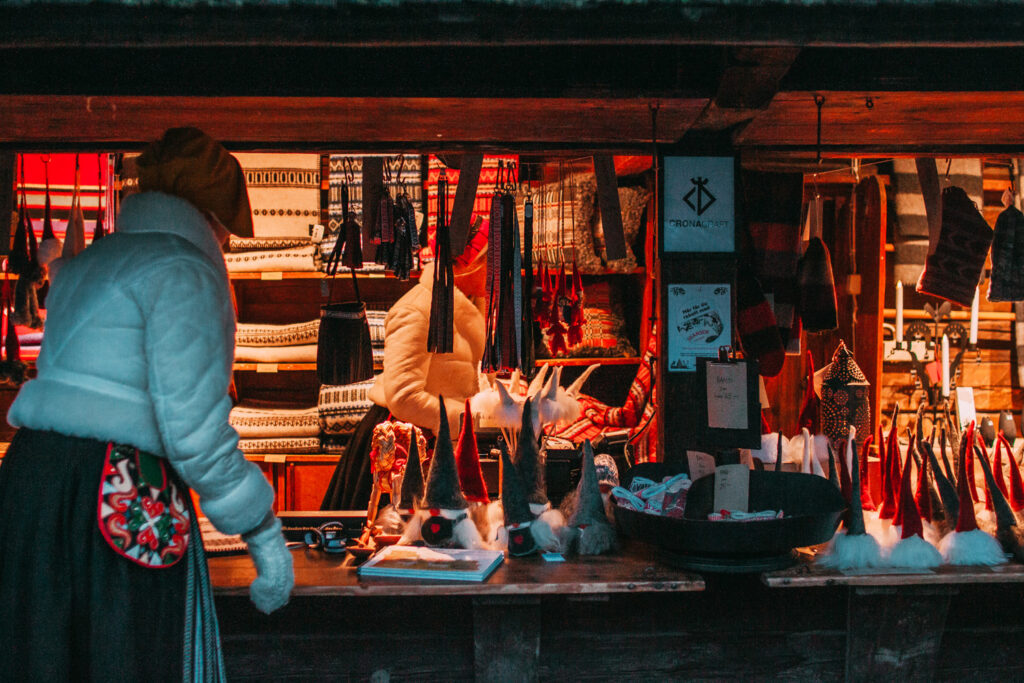
One fun little stall which I found in the market sold ‘mystery Christmas gifts.’ Each one cost 95 kr ($10 USD) and contained a secret gift. The items inside were all taken from the Skansen gift shop and related to the park itself or were Christmas themed. While most are valued at around 95, you might get lucky and pull a mystery item worth even more! These are great little surprises for both kids and adults alike! Plus, you can buy yourself a present and be able to still be surprised by what you find when you open it.

Be sure to try out the chocolate lottery! You buy a ticket, reach into the tombola to pull out a number and see if you won! You could get nothing but could also win a chocolate gift ranging from small chocolate coins to a colossal gift basket! These games made the market place feel like a giant funfair, and the jolly atmosphere it created was infectious.

Bollnäs Square
In front of the marketplace is a large square called Bollnäs square. This is where you’ll find the enormous Skansen Christmas tree. Throughout the day, there are performances on stage by musicians in traditional attire. You can get into the spirit of the holidays and dance around the Christmas tree. Swedes dance hand in hand, in a circle around the tree as they sing.
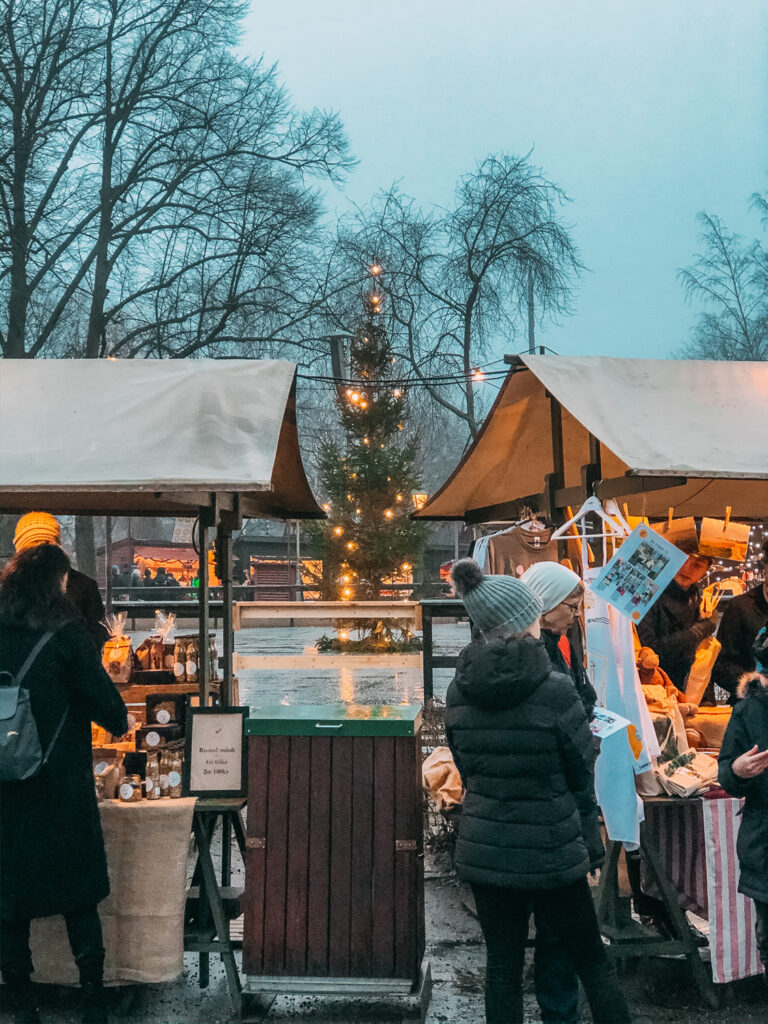

Oktorp Farmstead
The Oktorp farmstead (Oktorpsgården) from Halland shows what a farm in the flat countryside looked like in the 1870s. As the room appears at Skansen, it has been decorated for a festive occasion. It’s Christmas Eve around 1870, and the family is about to sit down for their dinner. The wall and ceiling are hung with woven linen cloths. The cloths are painted with biblical motifs and used for special occasions.
Farm Labourer’s Cottage
The Farm Labourer’s Cottage is an example of the more impoverished families who lived in Sweden in the 1900s. This small one-room cottage was inhabited by a large family. Despite the family being slow, they still celebrated Christmas in their own unique way.
Vala School
Across the Farm Labourers Cottage, you’ll find Vala School. This school building dates back to the 19th century when a law was passed requiring school-aged children to attend class all across Sweden. A Christmas party is held inside the school for one week before Christmas, where children can decorate gingersnap cookies.
Galejan Fairground
Market Weekends. Swings and roundabouts for small children. Galejan is the most charming funfair with swings and roundabouts for small children.
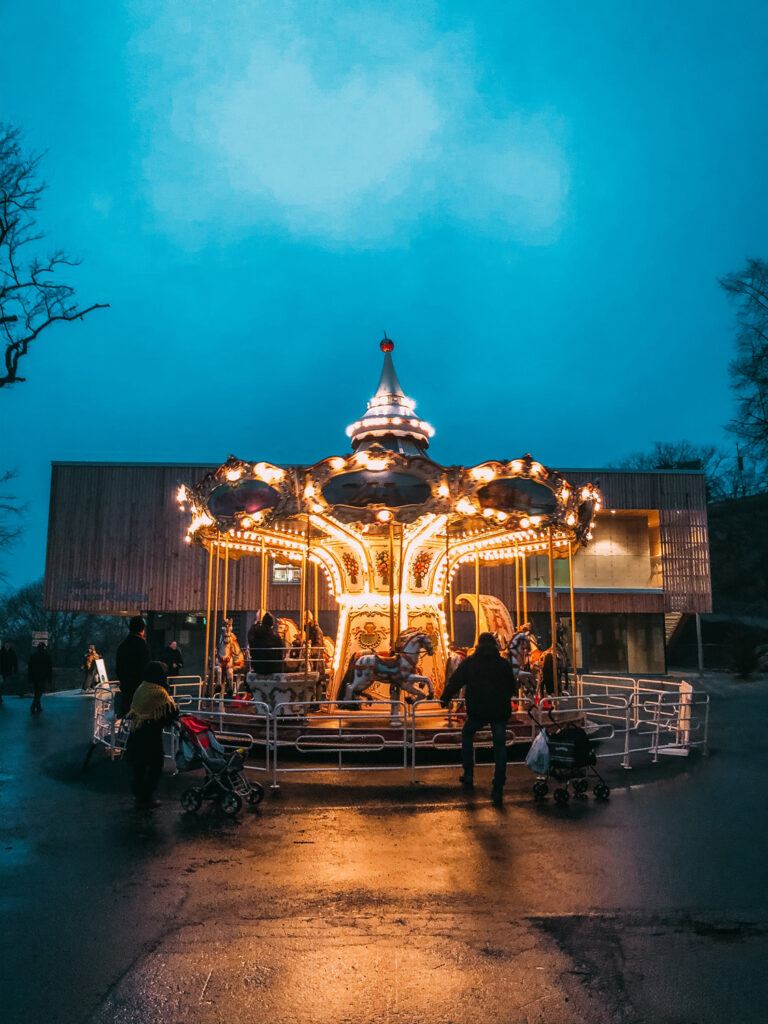
Stora Gungan Tavern
I would highly recommend booking a reservation at Stora Gungan Tavern to eat an early dinner before you leave. Inside this traditional tavern, built-in 1880, you can sample a traditional Swedish Christmas Smorgasbord. This includes rye bread topped with everything from pickled red onions, cold-smoked salmon, cod, egg, shrimps, and more. You can sip on carrot and ginger soup with a side of Christmas crispbread. For the main course, try the Swedish staple, meatballs with lingonberry jam, horseradish, cream sauce, cucumber, potatopurée. For dessert, sample their Skansen Pastry!
Christmas at Skansen is such a joy to visit, and just wandering the streets here brought a smile to my face! I hope you enjoyed your guided tour, and you left the park filled with the Christmas spirit!
Let me know in the comments if you’ve ever been to Skansen before or what you’re most looking forward to during their Christmas celebrations.
Happy Travels, Adventurers!
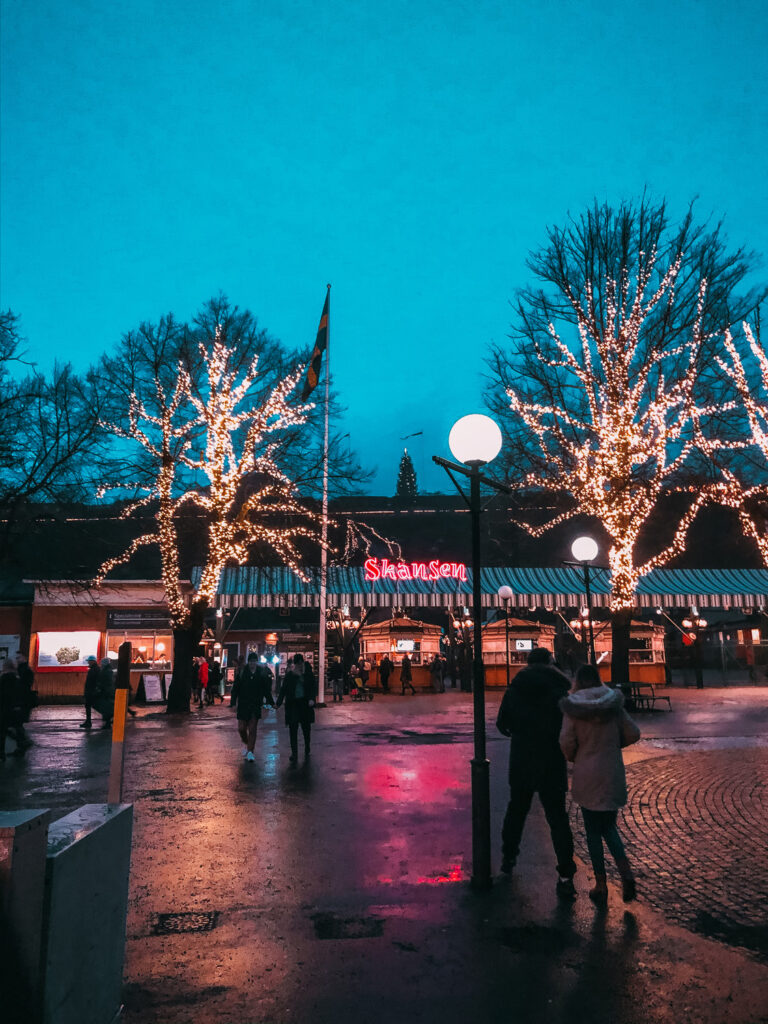
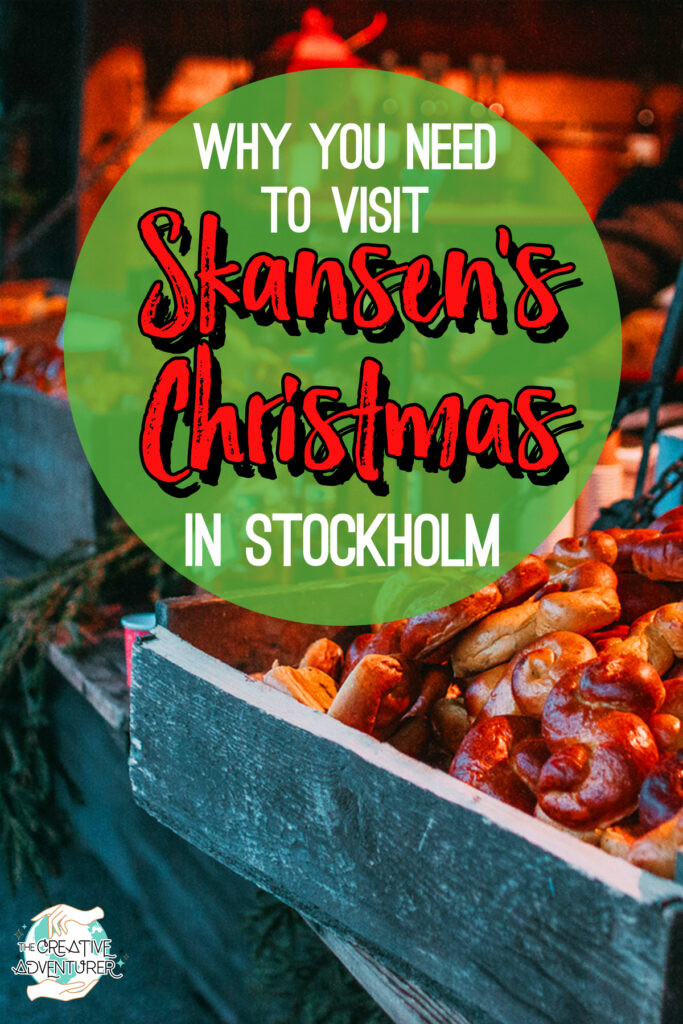

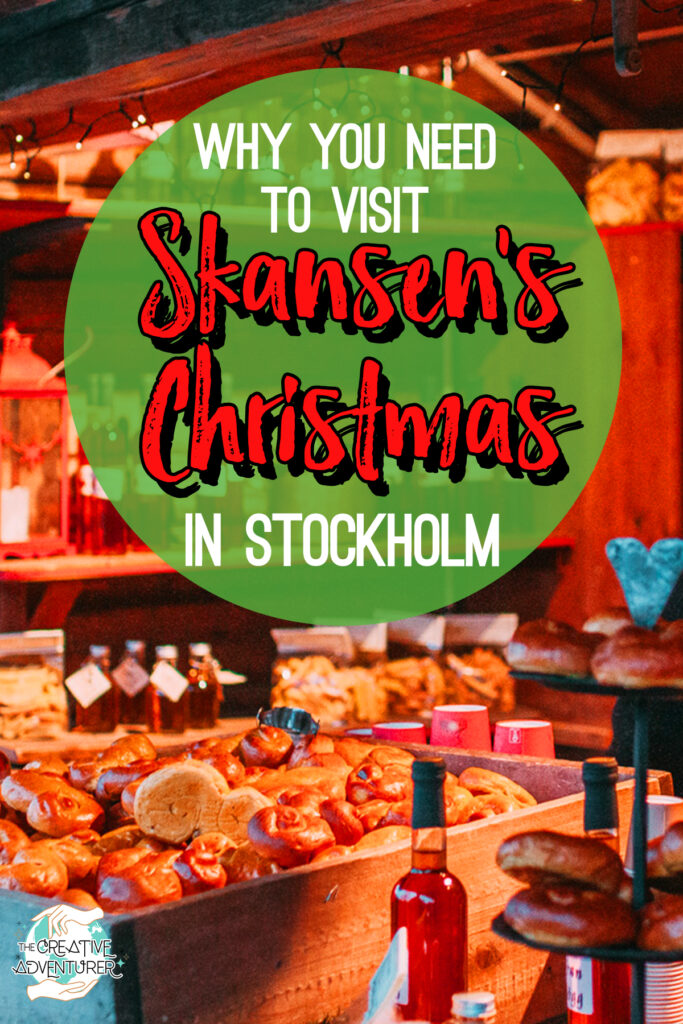
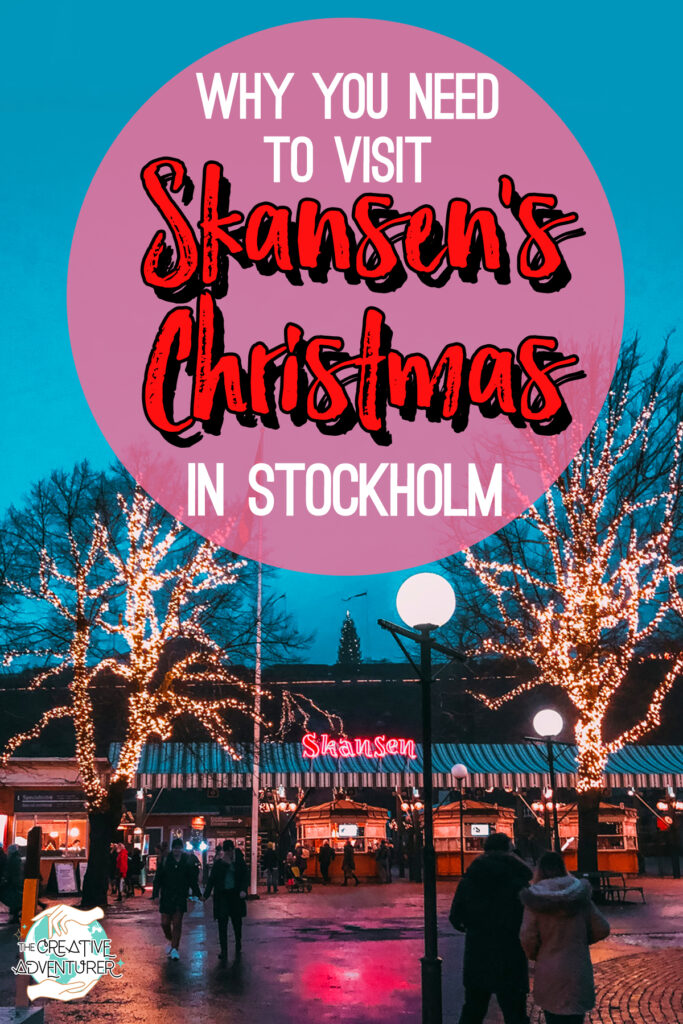
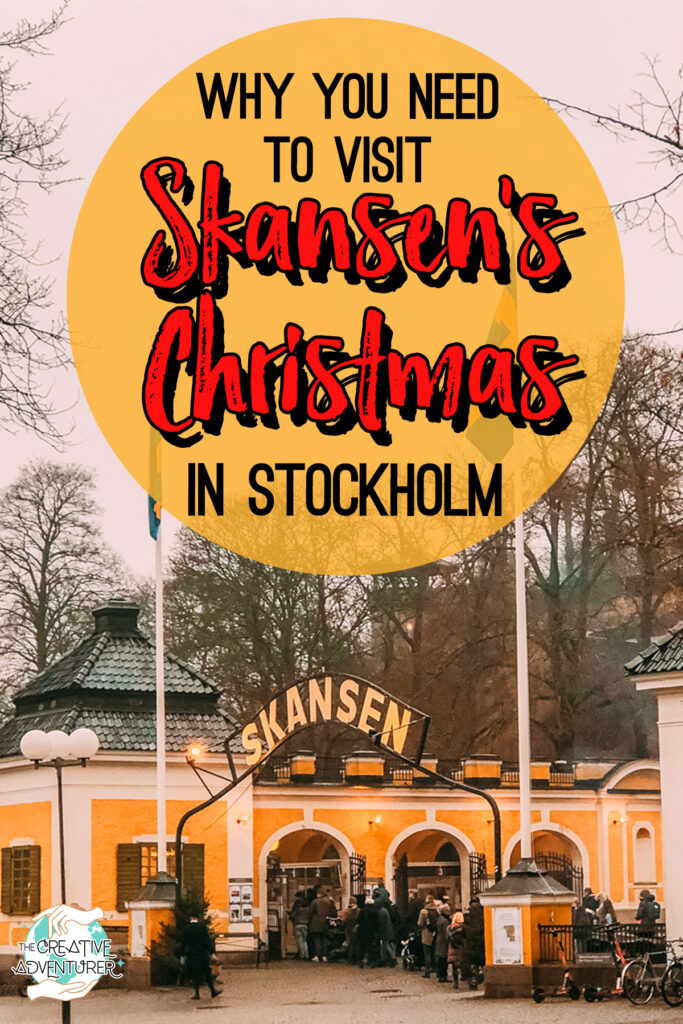
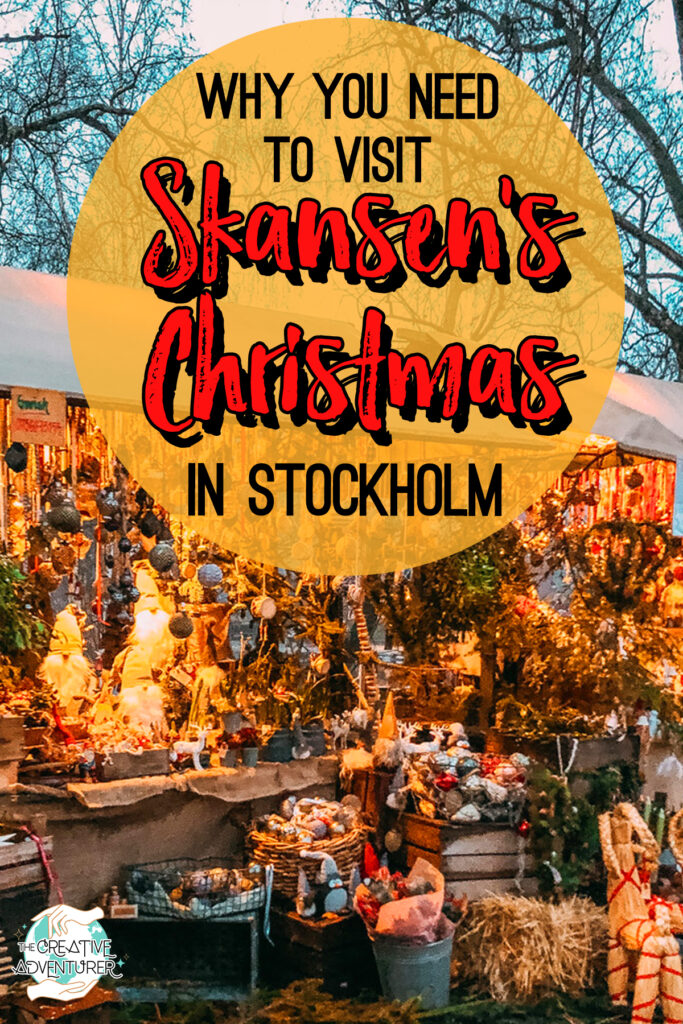


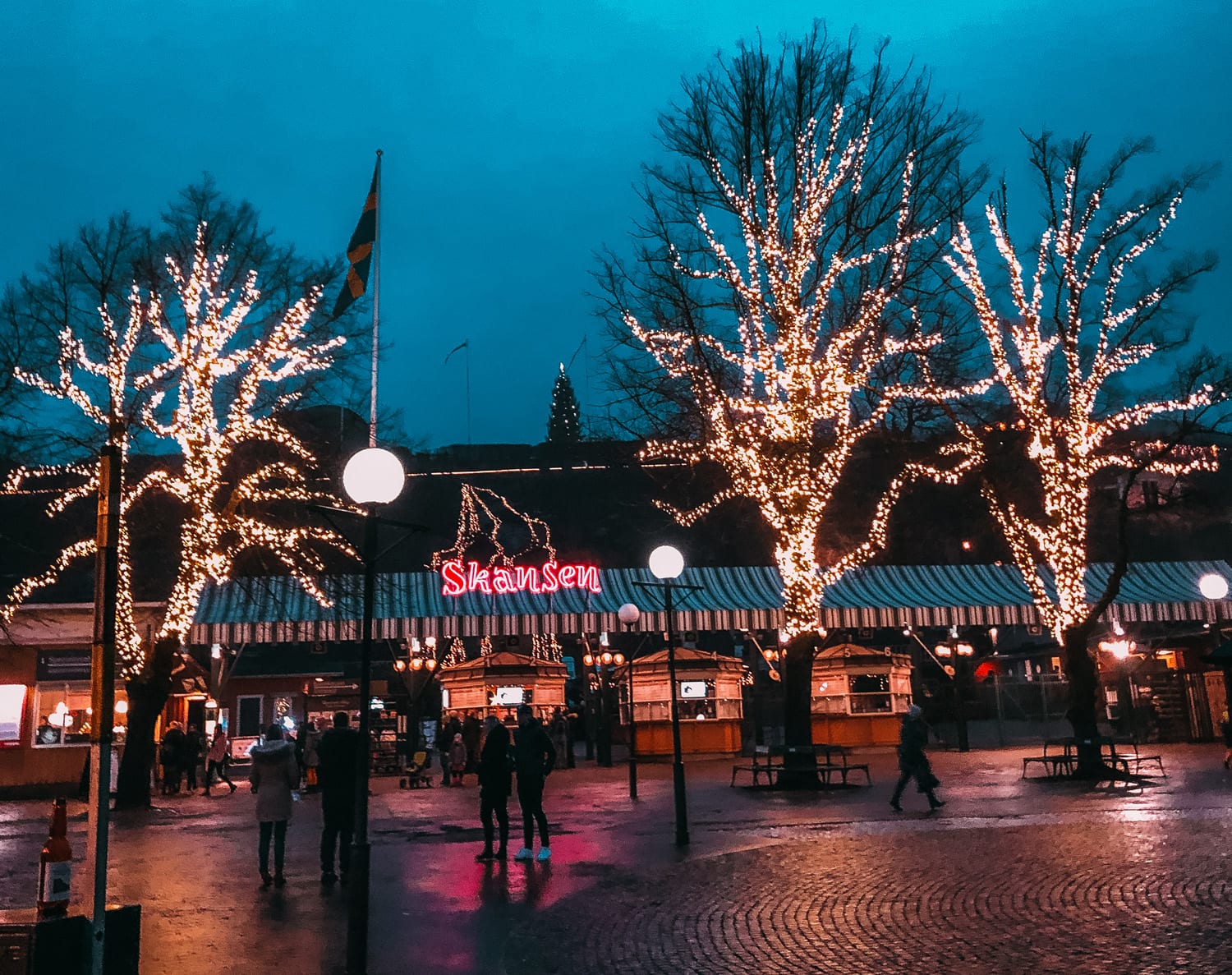
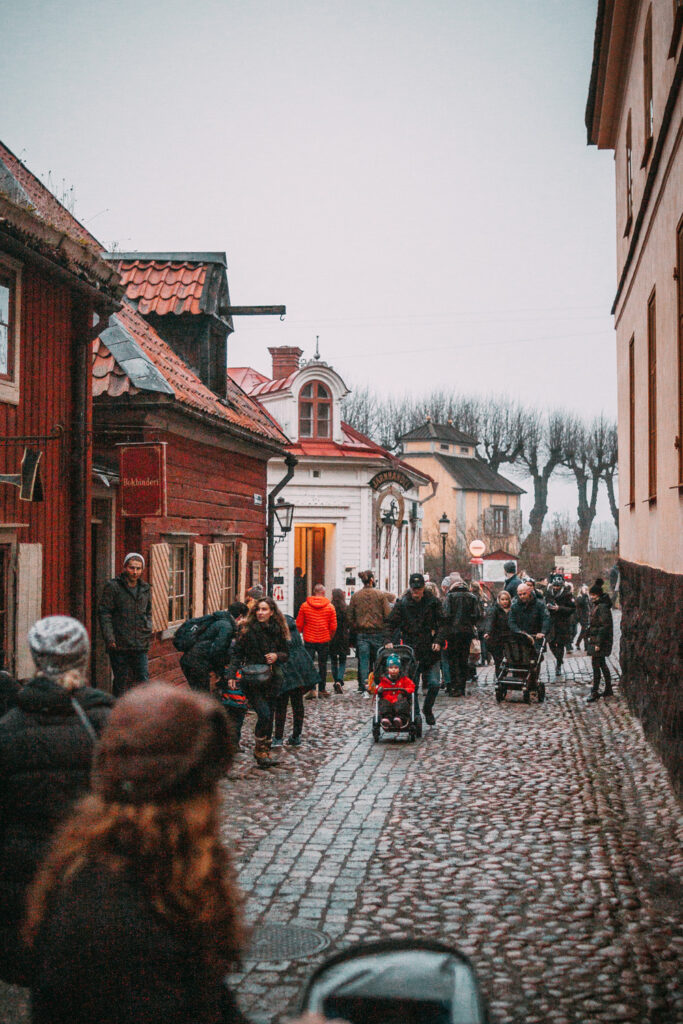
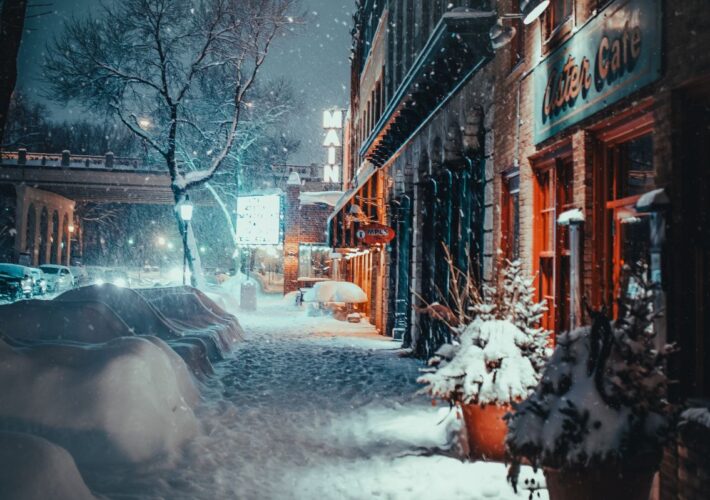
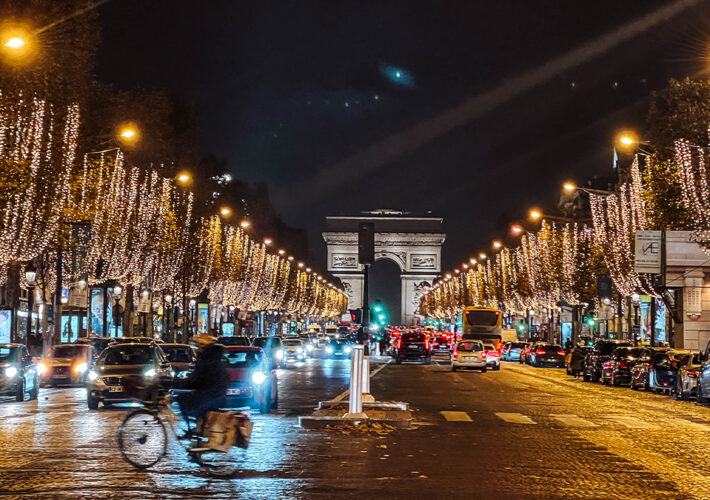
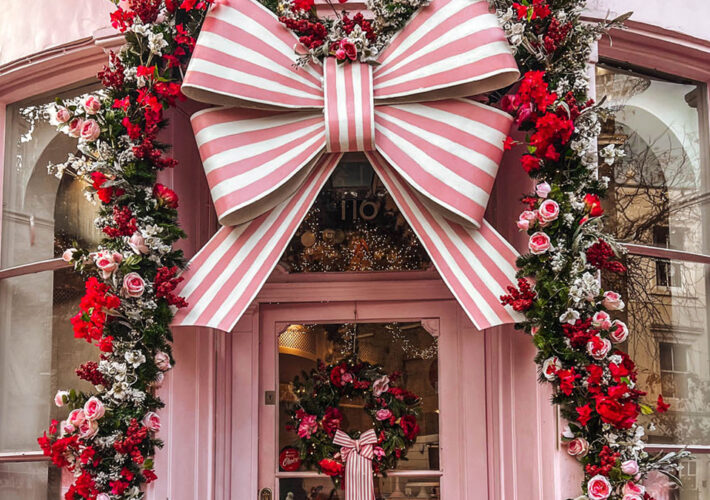
Leave a Comment